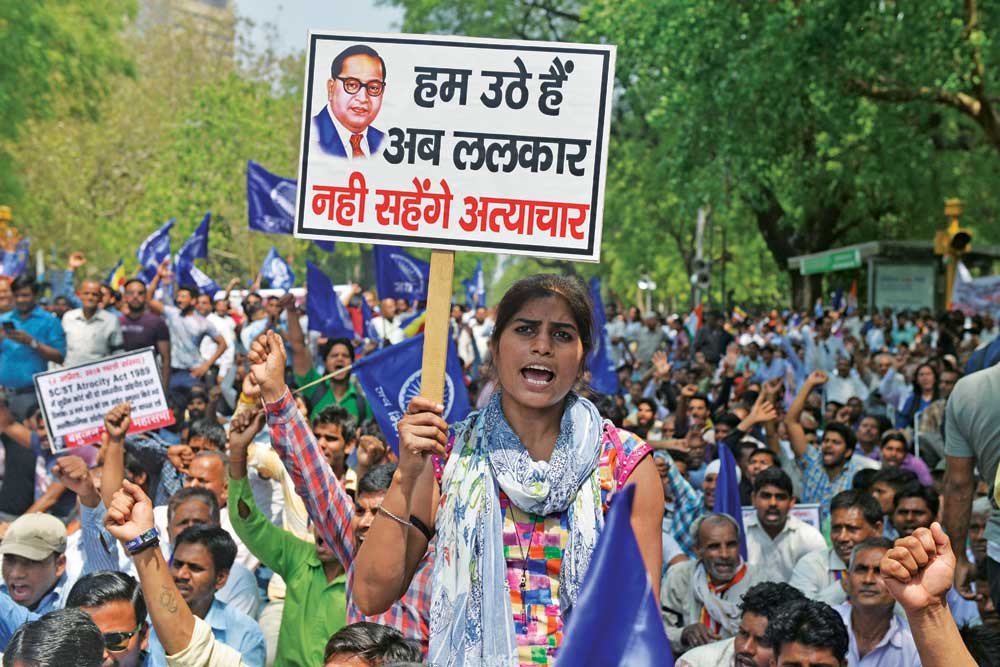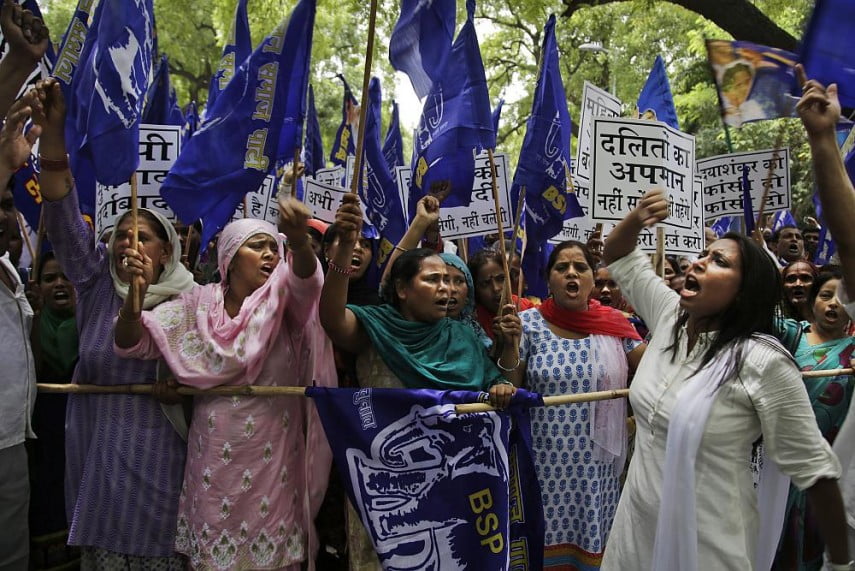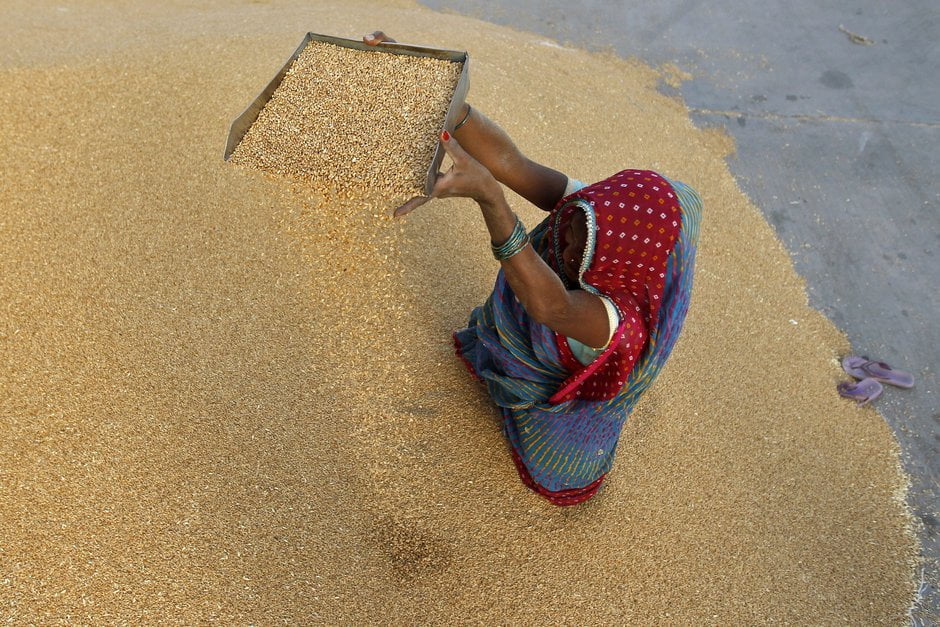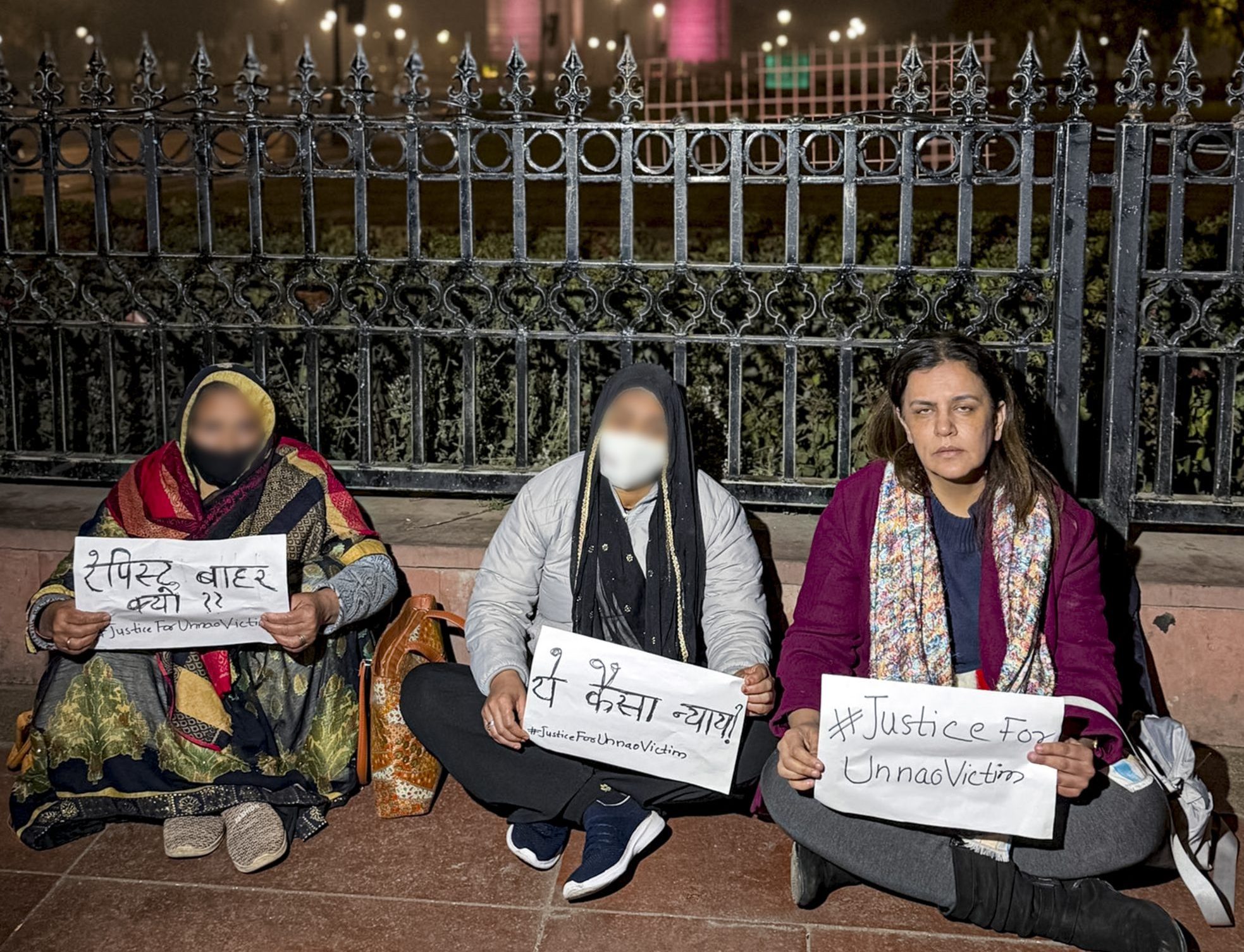Editor’s Note: This month, that is April 2020, FII’s #MoodOfTheMonth is Dalit History, where we invite various articles about historical moments in Dalit movements as well as Dalits (Ambedkar, Savitribai Phule) in history who have been part of the anti-caste movement in India. If you’d like to share your article, email us at pragya@feminisminindia.com.
Trigger warning: Sexual Violence Against Women, Rape, Violence Against Dalits
With the emergence of Dalit academia Dalit History month is celebrated signifying the birth of Dr. Ambedkar, which is an occasion to share the platform for Dalit academic literature and personal writings on lived experiences of exploitation and oppression. Ambedkar’s own writings and that of other Dalit scholars have been slow in coming of age in post- independent academic scholarship due to inherent marginalisation of Dalits as a source of sociological knowledge also due to intentional institutional neglect of Ambedkar’s theorisation of caste. The Brahminical social order has successfully attempted to keep feminist approach to read the complicity of caste, gender and sexuality also as their exclusive preserve.

It is now time that production of knowledge on caste should be dominated and highlighted by Dalits themselves. This knowledge production by Dalits has the tendency to reshape the way caste has been viewed not only in the intellectual academic space but in society in general.
One of my key observations as a legal Dalit feminist scholar has been that literature on Dalit women produced by Dalit feminist scholars is minimal. My aim is not to undermine or critique feminist knowledge production on the question of Dalit women by upper-caste feminist scholars but to merely highlight the fact that not enough Dalit women have been able to access the privilege of producing intellectual work on the experiences of Dalit women. A Dalit woman is unique and her experiences are largely different from not only upper-caste women but Dalit men as well. This identity needs to be embraced, questioned and further understood through the lens of complex intersectionality.
This article attempts to highlight the Dalit woman’s body and experiences within the Indian courtrooms and judiciary. It not only aims to assert that the Dalit woman’s experience of violence, oppression and vulnerability results in systemic oppression; even the last resort i.e., the courtroom is not built to protect and ensure basic rights. It not only fails them but exploits them and discriminates them at every step in the struggle to obtain justice.
The process of justice redressal for Dalit women itself leads to new levels of harassment, the hierarchies of caste and gender deeply embedded in state structures and social bias lead to a whole new struggle. The legal mechanism and the language of the law is limiting due its structural frameworks. The courts and legal processes are ignorant and lack sensitivity when dealing with the cases of violence against Dalit women.
The process of justice redressal for Dalit women itself leads to new levels of harassment, the hierarchies of caste and gender deeply embedded in state structures and social bias lead to a whole new struggle. The legal mechanism and the language of the law is limiting due its structural frameworks. The courts and legal processes are ignorant and lack sensitivity when dealing with the cases of violence against Dalit women.
In order to contextualise this, I will use two famous cases of atrocities against Dalits as an entry point to underline the Dalit woman’s experience within the Indian courtrooms. It should exhibit how the law and its mechanisms fail to comprehend the complexity of oppression that continues to surround Dalit women even while attempting to access justice.
The first judgment that I shall use is the well known case of Bhanwari Devi. The Bhanwari Devi case sparked a movement which later resulted in the formation of the Sexual Harassment at Workplace laws. However, despite the popularity of this case gained throughout India (so much so that a movie starring Nandita Das was made on this issue) the realisation, assertion and importance of Bhanwari Devi’s caste is ignored or rather non-existent not only in the general discourse curated by the media but even within legal and feminist scholarship.
The second (once again well known and popular) judgement that I shall elaborate on is the Khairlanji Massacre. This case gives prominence to the brutal atrocities committed against Dalits by upper caste perpetrators and how the legal system fails them at every step of the dispensation of justice. However, again the important emphasis laid here is that the atrocities that took place against the women of the Bhotmange family were overshadowed by the larger discourse of violence against Dalits.
Bhanwari Devi
Bhanwari Devi’s case is a case which demonstrates the influence of caste bias in the justice delivery system and the inability of lower caste women to obtain redressal.
The facts of the case are briefly highlighted below:
Bhanwari Devi joined the Rajasthan government’s Women’s Development Programme, as a Sathin worker. In April 1992, she reported an incident of child marriage of an one-year-old girl in the Gurjar community to the authorities. The police came to the village and tried to stop the ceremony. On September 22, 1992, in the presence of her husband, Bhanwari Devi was gang raped by members of the Gurjar family in retaliation for her intervention in the child marriage. Upon approaching the police, Bhanwari Devi was told however, that she was too old and unattractive to merit the attentions of young men and that as she was a lower caste woman, a Gurjar man could not have raped her as he wouldn’t touch an untouchable.
Interestingly, this case was a watershed movement which led to legislation of law for Sexual Harassment at the Workplace, however, nowhere in the Supreme Court judgement can one read about the harassment faced by Bhanwari Devi because of her caste, the harassment by the men in the village, the harassment by the police when filing her complaint and the harassing comments by the judge in the District court judgement.
The trial judge acquitted the accused with the reason that, “Rape is usually committed by teenagers, and since the accused are middle-aged and therefore respectable, they could not have committed the crime. An upper-caste man could not have defiled himself by raping a lower-caste woman.” This is precisely the language used by the “honourable judges” in Indian courts. The Scheduled Castes and Tribes (Prevention of Atrocities) Act, 1989 was not implemented.
Judgments have the power to change the way society functions and provide structures for the society to instill Rights based ideals of equality and basic Human Rights. Judges are bestowed with the responsibility of providing justice and setting precedents which have the power to transform society and rid it off inequality and discrimination. However, the judgment discussed above and the language used in this judgment shows an inept recognition of caste and its complexities.
Even the Supreme Court’s failure to acknowledge how caste played an extremely vital role in this incident merely exhibits the impunity enjoyed by the perpetrators of caste based violence. Neither have the debates nor discourses in relation to this case have raised the question of the lack of implementation of PoA Act. Interestingly, this case was a watershed movement which led to legislation of law for Sexual Harassment at the Workplace, however, nowhere in the Supreme Court judgement can one read about the harassment faced by Bhanwari Devi because of her caste, the harassment by the men in the village, the harassment by the police when filing her complaint and the harassing comments by the judge in the District court judgement. The judgement had the scope to raise the question of caste and create precedence for a more sensitised approach to victims of caste based gender violence.
Khairlanji Massacre
The Khairlanji case is infamous for the spectre of caste-based violence. This incident has been widely narrated and discussed as one of the key examples of upper caste perpetrators normalising gruesome forms of violence against Dalits who dare to resist upper caste hierarchy, power and control.
As narrated by the sources following the case and press accounts; the Bhotmanges were a Dalit family of Khairlanji who owned a small plot of land and had resisted the attempts of the dominant upper caste members of the village to construct a road through the land. On September 29, 2006, a mob of villagers attacked them. The charge of rape was not brought against the accused. Yet a police complaint on the grounds of rape, stripping, and parading was not registered. It is commonly assumed that if a charge is not brought before the court, the violence did not happen.
The Nagpur Bench of the Bombay High Court in 2006 stated that the PoA Act was not applicable to the Khairlanji case because, in their perception, there was no caste angle to the crime. This is not the first instance where the court ignores such a plea to penalise under the PoA Act; several cases registered under the Act claim that caste was not a factor whereas the victims were targeted due to their case in the first place.
The Nagpur Bench of the Bombay High Court in 2006 stated that the PoA Act was not applicable to the Khairlanji case because, in their perception, there was no caste angle to the crime. This is not the first instance where the court ignores such a plea to penalise under the PoA Act; several cases registered under the Act claim that caste was not a factor whereas the victims were targeted due to their case in the first place. The Bombay High Court in its 2010 judgement, stated the reason for the atrocity was personal rivalry and revenge, a usual ploy of the defendant for the miscarriage of justice.
The High court even failed to mention that a woman’s naked body should have been a cause of suspicion of sexual violence and due examination should have been conducted. The High Court saw the incident in the legal structure as motive formed from a single event which overlooks the way caste functions and dominates in all spaces.
Also read: Bhanwari Devi: A Hero We Failed
Analysis Of Both The Cases
There are certain themes which are evidently visible in both the cases discussed above. Both incidents have assertive women who chose to stand against upper caste hierarchy but faced the wrath of the powerful upper caste men. The first method for revenge for any form of retaliation by Dalits is that of sexual abuse and rape against women. Rape as a tool of revenge is normalised to the extent that even the courts and police not only fail to implement the atrocity through due legal process but they make it invisible.
the justice system in itself becomes a mechanism which continuously embeds casteism by failing to recognise an incident of atrocity as an atrocity under the PoA Act. Consequently, the legal system becomes a system which serves the interests of the wealthy and powerful by protecting them against the demands of the subaltern.
Secondly, the justice system in itself becomes a mechanism which continuously embeds casteism by failing to recognise an incident of atrocity as an atrocity under the PoA Act. Consequently, the legal system becomes a system which serves the interests of the wealthy and powerful by protecting them against the demands of the subaltern. The court fails to not only implement PoA Act and recognise gruesome crimes against Dalits as a direct result of caste, thus embedding caste further but they further deepen caste by their own flawed and inadequate understanding of society.
This article is an attempt to critique the way caste and gender are read in the Indian law, it has tried to highlight how law fails to understand caste based violence, thereby making the legal mechanisms for the protection of Dalits not only inadequate, but dysfunctional. In the current political climate, the PoA Act has been at the risk of being diluted one has to argue beyond stating that cases of atrocities are every day occurrences.
Also read: The Khairlanji Massacre Still Continues To Haunt The Brahmanical State
It is important to analyze that the law has been an inadequate mechanism to curb the menace of caste based violence and discrimination. Further, the Dalit woman’s body is at times subjugated to more discrimination or merely made invisible in Indian courts. However, inadequacy of the law is not the only critique it is also that the law, which is looked at as a tool of social transformation and protector of rights is in itself discriminatory. It is not always equitable, just or fair.
References
- On Interpreting as/and Atrocity.” In Public Secrets of Law: Rape Trials in India, by Pratiksha Baxi
- Court Decisions and The Common Law by Charles E. Carpenter
- The Bereft of Being: The Humiliations of Untouchability by V. Geetha In Humiliation: Claims and Contexts, by Gopal Guru.
- Human Rights Watch
- India Kanoon
- From Mathura to Manorama: Resisting Violence Against Women in India by Ritu Menon And Kalpana Kannabiran
- Understanding Sirasgaon: Notes Towards Conceptualising the Role of Law, Caste and Gender in a Case of Atrocity (In Gender and Caste) by Anupama Rao
- Unravelling the Kamasutra by Kumkum Roy In A Question of Silence? The Sexual Economies of Modern India, by Janaki Nair and Mary E John
- Tuka Ram & Anr. v. State of Maharashtra. 1979. 1979 AIR 185 (Distric Court).
- Tuka Ram & Anr. v. State of Mahrashtra. 1979. 1979 SCR (1) 810 (Supreme Court).
- Vishakha & Ors. v. State of Rajasthan. 1997. (JT 1997 (7) SC 384 (Supreme Court ).
Santvana Kumar is a Research Scholar at Centre for Women’s Studies, Jawaharlal Nehru University. She is a Human Rights Lawyer (NLIU). Her Research interests are law, caste, gender, race and intersectionality. Santvana is currently researching on Dalit feminism, Identity, the Law and reading Ambedkar’s writings as key jurisprudential theories. You can find her on Academia, Twitter, Instagram and Facebook.
Featured Image Source: Outlook India





Great work done .??
The article provokes us to re think… Has the Dalit Women’s question been overshadowed by the Feminist movement? This is with reference to the The Bhanwari Devi Case and the historic sexual harassment at workplace judgement that followed thereafter.